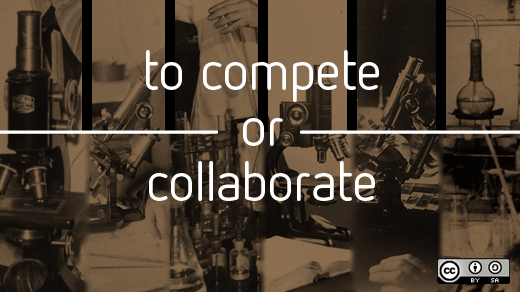Lately I've been knocking off a few books that have accumulated on my must-read list. One of my favorites is actually a recommendation from my technical sales professor at SAIT (my local polytechnical college): Predictably Irrational, by Dan Ariely.
My professor recommended it because of its insights around behavioral science, specifically the factors that influence a buyer's decision-making practices. And it reads quite satisfactorily for that. However, as an open source enthusiast, I found one chapter particularly interesting.
The cost of social norms
In chapter 4, "The Cost of Social Norms," Ariely discusses social norms and market norms. Social norms are the behavioral rules that a group or society considers acceptable. Market norms are what one is willing to accept (or give) payment for; they're usually reflective (in some form) of business transactions.
For example, a social norm may be a friend asking you to help them move, or bringing a bottle of wine to your friends place when they've offered to host dinner. Ariely describes social norms as "warm and fuzzy," and not requiring immediate payback.
But he describes market norms as neither warm nor fuzzy. They're sharp-edged, devoid of feelings or emotion, and transactional in nature: rent, wages, prices, interest, and other costs and benefits. With market norms, you get what you pay for. Ariely starts off the chapter with this:
You are at your mother-in-law's house for Thanksgiving dinner, and what a sumptuous spread she has put on the table for you! The turkey is roasted to a golden brown; the stuffing is homemade and exactly the way you like it. Your kids are delighted: the sweet potatoes are crowned with marshmallows. And your wife is flattered: her favorite recipe for pumpkin pie has been chosen for dessert.
The festivities continue into the late afternoon. You loosen your belt and sip a glass of wine. Gazing fondly across the table at your mother-in-law, you rise to your feet and pull out your wallet. "Mom, for all the love you've put into this, how much do I owe you?" you say sincerely. As silence descends on the gathering, you wave a handful of bills. "Do you think three hundred dollars will do it? No, wait, I should give you four hundred!"
This is not a picture that Norman Rockwell would have painted. A glass of wine falls over; your mother-in-law stands up red-faced; your sister-in-law shoots you an angry look; and your niece bursts into tears. Next year's Thanksgiving celebration, it seems, may be a frozen dinner in front of the television set.
In this paragraph, Ariely illustrates mixing a social norm (a dinner invitation) with a market norm (paying for the cost of dinner). Throughout this chapter, he demonstrates the value of social norms.
For instance, he discusses one experiment in which lawyers are presented with a reduced wage opportunity to give legal advice to clients who can't afford to hire a lawyer. The lawyers choose to offer their services for free. They felt that if the intent is to give legal advice to those who need it and yet struggle to afford it, then the moral thing to do would be to not charge them at all. In this case, then, they used the funds intended for their wages to create communities and market their volunteer efforts. Thus, this social norm helped establish the pro bono law societies we currently see in the legal profession.
In another study, two groups of university students received identical group assignments. One group received a version of the assignment wrought with market norm wordings, the other with neutral wordings. The question driving this experiment was: Would thinking about money and market norms in this manner be sufficient to change the way the students behaved? Professors later discovered that the students given the market norm assignments were less likely to ask questions, took longer to ask for help, were less likely to help others, were more likely to select tasks that required individual input rather than teamwork, and generally behaved in a more selfish and self-reliant way.
Time and again, Ariely illustrates market norms entering our considerations can push social norms aside—and actually displace social norms in ways that damage relationships (think back to the Thanksgiving dinner example and how your mother-in-law may feel after you offered to pay her for dinner).
Striking a balance
Now, what does this have to do with open source?
Well, open source projects function on both social and market norms. On one hand, we see corporate sponsors or contributors who are being paid to write code; on the other, we see several highly skilled, intelligent people contributing not for monetary gain, but because they value the community and the goodwill purpose of the project. These people identify with the altruistic ideal of giving back to others and the recognition that comes with it.
Open source contributors happily sacrifice their limited spare time to give their skills and intellectual property away for free. And why? What on earth for? Why would someone chose to do that for free when they could be getting paid to do it?
Because, as Ariely and the open source community illustrate, social norms are stronger than market norms. In The Open Organization, Jim Whitehurst asserts that opening up your organization by applying the ethos of open source can engage and enable employees to add value to your business in ways that go beyond traditional trickle down executive strategy. For example, Red Hat's partner ecosystem is a community of competing corporations that collaboratively work together and contribute to each other's products despite being market rivals!
Unsurprisingly, Ariely actually references Linux and open source in this particular chapter:
Open source software shows the potential of social norms. In the case of Linux and other collaborative projects, you can post a problem about a bug on one of the bulletin boards and see how fast someone, or often many people, will react to your request and fix the software—using their own leisure time. Could you pay for this level of service? Most likely. But if you had to hire people of the same caliber they would cost you an arm and a leg. Rather, people in these communities are happy to give their time to society at large (for which they get the same social benefits we all get form helping a friend paint a room). What can we learn from this that is applicable in the business world? There are social rewards that strongly motivate behavior—and one of the least used in corporate life is the encouragement of social rewards and reputation.
This social norm movement has proliferated recently with the evolution of corporate policy surrounding work-life balance. Google helped pioneer the practice of bridging social and market norms by providing social benefits such as gourmet meals on campus, on-site health and wellness services, or the 20 percent time allotment for personal projects. Now on-site fitness facilities, subsidized public transit, or healthy snacks are becoming more common among some companies, who are beginning to see the value of the employer-employee social relationship.
On a related note, Ariely mentions startup culture. The level of work startups get out of their people when social norms (such as the excitement of building something together) are stronger than market norms (salary increases with each promotion) is remarkable, he says.
Ariely also discusses emergency and essential service professions: salary alone will not motivate people to risk their lives. Police officers, firefighters, soldiers—they don't risk death for their weekly pay. Rather, it's the social norms (pride in their profession, and sense of duty) that motivate them to risk their lives and their health.
The value of social norms
So how does this benefit open source? What impact do we see from social and market norms? Well, let's take the Linux kernel for example. It started out entirely as a socially motivated project that's now evolved into a hybrid of both forces. Although, Linux development is still predominantly driven by social norms. Kernel history statistics from the latest release (gathered by Greg Kroah-Hartman) show a massive impact from both market and socially motivated contributors:
- 430 companies contributed to the 3.15-4.0 Linux kernel versions
- 3,711 developers contributed
- Over 19 million lines of code in total for the project (although this metric only tells part of the story for project size or complexity)
- On average 193.71 changes are made per day, or 8.07 changes per hour
This predominantly social effort has grown to be the largest collaborative software project in the world; it's the leading operating system across mobile devices, data centers, and in the cloud, and has recently been valued at $5 billion.
That's a staggering amount of impact and value from social motivators.






Comments are closed.